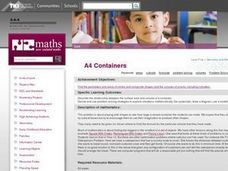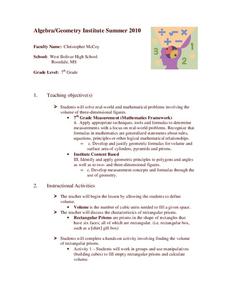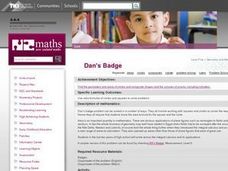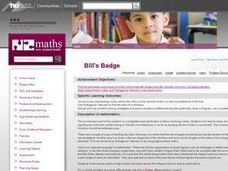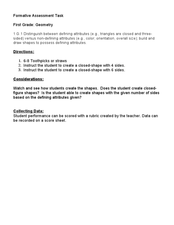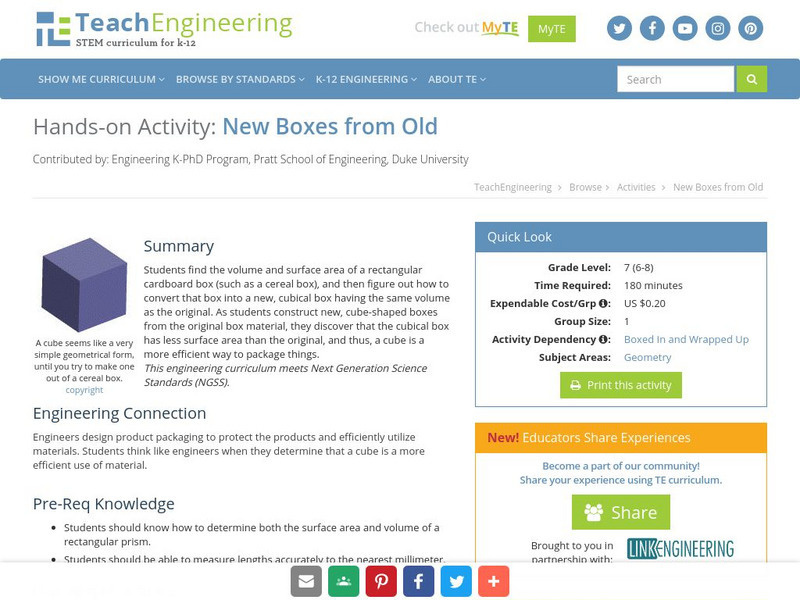Curated OER
A4 Containers
Fifth graders determine which container made from a single sheet of paper has the greatest volume. They look the solutions made by three different students before working on their own examples.
American Statistical Association
Exploring Geometric Probabilities with Buffon’s Coin Problem
Scholars create and perform experiments attempting to answer Buffon's Coin problem. They discover the relationships between geometry and probability, empirical and theoretical probabilities, and area of a circle and square.
Curated OER
Measurements
Seventh graders solve word problems involving real world situation. In this geometry lesson, 7th graders solve problems related to volume. They apply the formulas taught in geometry.
Curated OER
Penny's Box
Students need to be able to calculate the volume and surface area of a cuboid as well as present a systematic list of results in order to justify the minimum case. The use of three factors of 100 is also important.
Curated OER
Dan's Badge
Students solve a math problem using area formulas of circles and squares. They read and discuss the problem, analyze images of badges, reconstruct the badge from the problem using circles and rulers, and share the solution with the class.
Curated OER
Peter's Second String
Fifth graders determine the maximum area and range of areas of a rectangle with a given perimeter. They discuss a word problem involving perimeter and area as a class, investigate the word problem using a piece of string, and in small...
Curated OER
Marshmallow Geometry
In this three-dimensional shapes geometry instructional activity, learners identify geometric solids and name their properties. They define "face," "edge," and "vertex," and construct geometric solids using marshmallows as vertices and...
Curated OER
Round The Track
Fourth graders develop problem solving skills while learning to measure an athletic track. The focus upon logic and reasoning is helpful for all types of science and math calculations.
Curated OER
Bill's Badge
Learners explore the making of circles and concepts related to them in geometry. The project is inquiry based will focus upon students making their own nametags. The construction is ideal for hands on learners.
Curated OER
Square Pegs in Round Holes
Sixth graders problem solve the square peg in the round whole problem by applying knowledge of the formulas for the areas of the circle and the square. They decide on a problem solving strategy based on logical reasoning.
Curated OER
Fences and Posts
Fifth graders use Geoboards to demonstrate how shapes can be made by looping the rubber bands over the nails. They make a triangle on their Geoboards. At least one side of the triangle should be either horizontal or vertical. The picture...
Curated OER
Around We Go
Fourth graders investigate a range of circles, each with a different radius, diameter and circumference and assemble this information in their search for relationships.The measurement of circles and the relationships to be found within...
Curated OER
Karen's Tiles
Students investigate how perimeter changes as area changes to see the relation between area and perimeter for similar shapes. They then students answer the question if the area of the rectangle increase, does its perimeter have to increase?
Curated OER
Check Out Lights and Shields with Beads
Students explore Ultraviolet detecting beads and conduct several investigations with them. In this investigative instructional activity students participate in an experiment to see the harmful effects of UV light and discuss their...
Curated OER
Cones, Cylinders, Spheres
Students classify polygons by name and shape. For this geometry lesson, students identify the lateral surface of each conic. They differentiate between cones, cylinders and spheres.
Curated OER
Geometry
Students are introduced to the basics of Geometry. Using cutout shapes, they identify whether they are polygons by using the properties of polygons. They practice drawing shapes they are going to be using on an everyday basis and...
Curated OER
Houses
Third graders use a number of problem solving strategies in this unit of lessons. They determine how to draw and model three-dimensional objects, use co-ordinate systems, determine probability of events, and identify paths of simple...
CK-12 Foundation
Ck 12: Geometry: Surface Area and Volume of Prisms
[Free Registration/Login may be required to access all resource tools.] This concept teaches students how to calculate the surface area and volume of prisms.
TeachEngineering
Teach Engineering: Boxed in and Wrapped Up
Students find the volume and surface area of a rectangular box (e.g., a cereal box), and then figure out how to convert that box into a new, cubical box having the same volume as the original. As they construct the new, cube-shaped box...
Better Lesson
Better Lesson: Covering and Filling: Surface Area & Volume of Rectangular Prisms
Students apply their knowledge of surface area and volume to solve some problems for a box company. This lesson contains a detailed lesson plan, video explanations, rubrics, group work guidelines, slides containing problems, and...
Better Lesson
Better Lesson: Fractions and Volume
Creating a conceptual understanding of how to find the volume of rectangular prisms using fractional side lengths.
Better Lesson
Better Lesson: Prism or Pyramid?
Sixth graders explore the faces, bases, edges, and vertices of prisms and pyramids to help develop the concepts of volume and surface area.
Better Lesson
Better Lesson: Exploring Volume
Modeling volume with centimeter cubes deepens understanding of the formula for finding volume.
TeachEngineering
Teach Engineering: New Boxes From Old
Students find the volume and surface area of a rectangular box (e.g., a cereal box), and then figure out how to convert that box into a new, cubical box having the same volume as the original. As they construct the new, cube-shaped box...
